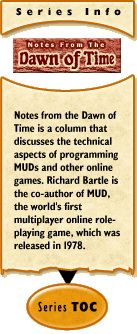
|
Questions and Answersby Richard Bartle Last time, I presented a diagram that represented the "thought processes" of Doris the dwarf as she set about her quest to, er, have a quest. Because such a diagram is structured, it means that the goals and actions appear (to human beings) to be "reasoned" and purposeful. A side effect is that players can pose questions and get seemingly "reasoned" answers. Why? questions refer to nodes higher up in the tree.
How? questions refer to nodes lower down in the tree.
Which?/What?/Who?questions refer to variable bindings.
When? questions can be answered relative to parts of the tree, but unless the planner has some temporal management they can't be answered more specifically.
How? and Why? questions are limited by the nature of the tree. You can't go further up than the root.
You can't go lower than a primitive, hardwired action.
If you want to be really fiendish, there's some leeway for lying, too. The evil wizard who wants a lock of the princess's hair so he can create a simulacrum would not necessarily like you to know this when he sets it as a quest. Thus, he could simply find another action for which the goal is a precondition and use that as an answer instead. I want you to fetch me a lock of princess Charity's hair.
The plausibility of lies is what makes them work. If you keep questioning and come across things that are implausible or provably false, the lie is exposed. For this to work, lying mobiles would have to maintain a record of all the lies they have told, so if at all possible they don't contradict themselves. Even then, unless they do the whole false plan at once they can still reveal themselves: I want you to build me a tall tower.
That would be DOES NOT COMPUTE, then? Next time, I'll take a look at that most dread of quest concepts: spawning. |
